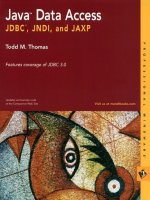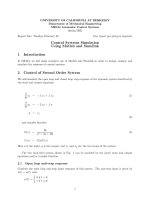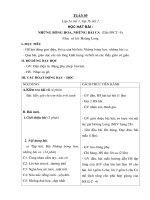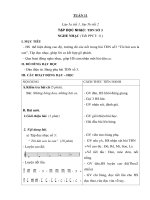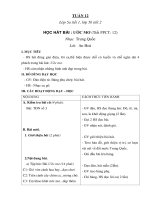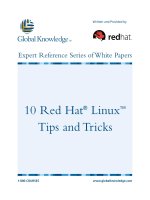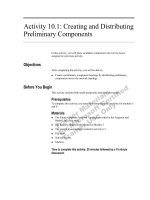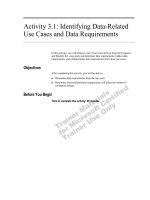Tài liệu Practical mod_perl-CHAPTER 1: Introducing CGI and mod_perl pptx
Bạn đang xem bản rút gọn của tài liệu. Xem và tải ngay bản đầy đủ của tài liệu tại đây (599.56 KB, 22 trang )
This is the Title of the Book, eMatter Edition
Copyright © 2004 O’Reilly & Associates, Inc. All rights reserved.
3
Chapter 1
CHAPTER 1
Introducing CGI and mod_perl
This chapter provides the foundations on which the rest of the book builds. In this
chapter, we give you:
• A history of CGI and the HTTP protocol.
• An explanation of the Apache 1.3 Unix model, which is crucial to understand-
ing how mod_perl 1.0 works.
• An overall picture of mod_perl 1.0 and its development.
• An overview of the difference between the Apache C API, the Apache Perl API
(i.e., the mod_perl API), and CGI compatibility. We will also introduce the
Apache::Registry and Apache::PerlRun modules.
• An introduction to the mod_perl API and handlers.
A Brief History of CGI
When the World Wide Web was born, there was only one web server and one web
client. The httpd web server was developed by the Centre d’Etudes et de Recherche
Nucléaires (CERN) in Geneva, Switzerland. httpd has since become the generic name
of the binary executable of many web servers. When CERN stopped funding the
development of httpd, it was taken over by the Software Development Group of the
National Center for Supercomputing Applications (NCSA). The NCSA also pro-
duced Mosaic, the first web browser, whose developers later went on to write the
Netscape client.
Mosaic could fetch and view static documents
*
and images served by the httpd server.
This provided a far better means of disseminating information to large numbers of
people than sending each person an email. However, the glut of online resources
soon made search engines necessary, which meant that users needed to be able to
* A static document is one that exists in a constant state, such as a text file that doesn’t change.
,ch01.20922 Page 3 Thursday, November 18, 2004 12:34 PM
This is the Title of the Book, eMatter Edition
Copyright © 2004 O’Reilly & Associates, Inc. All rights reserved.
4
|
Chapter 1: Introducing CGI and mod_perl
submit data (such as a search string) and servers needed to process that data and
return appropriate content.
Search engines were first implemented by extending the web server, modifying its
source code directly. Rewriting the source was not very practical, however, so the
NCSA developed the Common Gateway Interface (CGI) specification. CGI became a
standard for interfacing external applications with web servers and other informa-
tion servers and generating dynamic information.
A CGI program can be written in virtually any language that can read from
STDIN and
write to STDOUT, regardless of whether it is interpreted (e.g., the Unix shell), com-
piled (e.g., C or C++), or a combination of both (e.g., Perl). The first CGI programs
were written in C and needed to be compiled into binary executables. For this rea-
son, the directory from which the compiled CGI programs were executed was named
cgi-bin, and the source files directory was named cgi-src. Nowadays most servers
come with a preconfigured directory for CGI programs called, as you have probably
guessed, cgi-bin.
The HTTP Protocol
Interaction between the browser and the server is governed by the HyperText Trans-
fer Protocol (HTTP), now an official Internet standard maintained by the World
Wide Web Consortium (W3C). HTTP uses a simple request/response model: the cli-
ent establishes a TCP
*
connection to the server and sends a request, the server sends
a response, and the connection is closed. Requests and responses take the form of
messages. A message is a simple sequence of text lines.
HTTP messages have two parts. First come the headers, which hold descriptive infor-
mation about the request or response. The various types of headers and their possi-
ble content are fully specified by the HTTP protocol. Headers are followed by a
blank line, then by the message body. The body is the actual content of the message,
such as an HTML page or a GIF image. The HTTP protocol does not define the con-
tent of the body; rather, specific headers are used to describe the content type and its
encoding. This enables new content types to be incorporated into the Web without
any fanfare.
HTTP is a stateless protocol. This means that requests are not related to each other.
This makes life simple for CGI programs: they need worry about only the current
request.
The Common Gateway Interface Specification
If you are new to the CGI world, there’s no need to worry—basic CGI programming
is very easy. Ninety percent of CGI-specific code is concerned with reading data
* TCP/IP is a low-level Internet protocol for transmitting bits of data, regardless of its use.
,ch01.20922 Page 4 Thursday, November 18, 2004 12:34 PM
This is the Title of the Book, eMatter Edition
Copyright © 2004 O’Reilly & Associates, Inc. All rights reserved.
A Brief History of CGI
|
5
submitted by a user through an HTML form, processing it, and returning some
response, usually as an HTML document.
In this section, we will show you how easy basic CGI programming is, rather than
trying to teach you the entire CGI specification. There are many books and online
tutorials that cover CGI in great detail (see Our aim is
to demonstrate that if you know Perl, you can start writing CGI scripts almost imme-
diately. You need to learn only two things: how to accept data and how to generate
output.
The HTTP protocol makes clients and servers understand each other by transferring
all the information between them using headers, where each header is a key-value
pair. When you submit a form, the CGI program looks for the headers that contain
the input information, processes the received data (e.g., queries a database for the
keywords supplied through the form), and—when it is ready to return a response to
the client—sends a special header that tells the client what kind of information it
should expect, followed by the information itself. The server can send additional
headers, but these are optional. Figure 1-1 depicts a typical request-response cycle.
Sometimes CGI programs can generate a response without needing any input data
from the client. For example, a news service may respond with the latest stories with-
out asking for any input from the client. But if you want stories for a specific day,
you have to tell the script which day’s stories you want. Hence, the script will need
to retrieve some input from you.
To get your feet wet with CGI scripts, let’s look at the classic “Hello world” script for
CGI, shown in Example 1-1.
Figure 1-1. Request-response cycle
Example 1-1. “Hello world” script
#!/usr/bin/perl -Tw
print "Content-type: text/plain\n\n";
print "Hello world!\n";
Web Browser
Web Server
GET /index.html HTTP/1.1
HTTP/1.1 200 OK
Request
Response
,ch01.20922 Page 5 Thursday, November 18, 2004 12:34 PM
This is the Title of the Book, eMatter Edition
Copyright © 2004 O’Reilly & Associates, Inc. All rights reserved.
6
|
Chapter 1: Introducing CGI and mod_perl
We start by sending a Content-type header, which tells the client that the data that
follows is of plain-text type. text/plain is a Multipurpose Internet Mail Extensions
(MIME) type. You can find a list of widely used MIME types in the mime.types file,
which is usually located in the directory where your web server’s configuration files
are stored.
*
Other examples of MIME types are text/html (text in HTML format) and
video/mpeg (an MPEG stream).
According to the HTTP protocol, an empty line must be sent after all headers have
been sent. This empty line indicates that the actual response data will start at the
next line.
†
Now save the code in hello.pl, put it into a cgi-bin directory on your server, make the
script executable, and test the script by pointing your favorite browser to:
http://localhost/cgi-bin/hello.pl
It should display the same output as Figure 1-2.
A more complicated script involves parsing input data. There are a few ways to pass
data to the scripts, but the most commonly used are the
GET and POST methods. Let’s
write a script that expects as input the user’s name and prints this name in its
response. We’ll use the
GET method, which passes data in the request URI (uniform
resource indicator):
http://localhost/cgi-bin/hello.pl?username=Doug
When the server accepts this request, it knows to split the URI into two parts: a path
to the script (http://localhost/cgi-bin/hello.pl) and the “data” part (
username=Doug,
called the
QUERY_STRING). All we have to do is parse the data portion of the URI and
extract the key
username and value Doug. The GET method is used mostly for hard-
coded queries, where no interactive input is needed. Assuming that portions of your
* For more information about Internet media types, refer to RFCs 2045, 2046, 2047, 2048, and 2077, accessi-
ble from />† The protocol specifies the end of a line as the character sequence Ctrl-M and Ctrl-J (carriage return and new-
line). On Unix and Windows systems, this sequence is expressed in a Perl string as \015\012, but Apache also
honors \n, which we will use throughout this book. On EBCDIC machines, an explicit \r\n should be used
instead.
Figure 1-2. Hello world
,ch01.20922 Page 6 Thursday, November 18, 2004 12:34 PM
This is the Title of the Book, eMatter Edition
Copyright © 2004 O’Reilly & Associates, Inc. All rights reserved.
A Brief History of CGI
|
7
site are dynamically generated, your site’s menu might include the following HTML
code:
<a href="/cgi-bin/display.pl?section=news">News</a><br>
<a href="/cgi-bin/display.pl?section=stories">Stories</a><br>
<a href="/cgi-bin/display.pl?section=links">Links</a><br>
Another approach is to use an HTML form, where the user fills in some parameters.
The HTML form for the “Hello user” script that we will look at in this section can be
either:
<form action="/cgi-bin/hello_user.pl" method="POST">
<input type="text" name="username">
<input type="submit">
</form>
or:
<form action="/cgi-bin/hello_user.pl" method="GET">
<input type="text" name="username">
<input type="submit">
</form>
Note that you can use either the GET or POST method in an HTML form. However,
POST should be used when the query has side effects, such as changing a record in a
database, while
GET should be used in simple queries like this one (simple URL links
are
GET requests).
*
Formerly, reading input data required different code, depending on the method used
to submit the data. We can now use Perl modules that do all the work for us. The
most widely used CGI library is the
CGI.pm module, written by Lincoln Stein, which
is included in the Perl distribution. Along with parsing input data, it provides an easy
API to generate the HTML response.
Our sample “Hello user” script is shown in Example 1-2.
Notice that this script is only slightly different from the previous one. We’ve pulled
in the
CGI.pm module, importing a group of functions called :standard. We then used
its
param( ) function to retrieve the value of the username key. This call will return the
* See Axioms of Web Architecture at />Example 1-2. “Hello user” script
#!/usr/bin/perl
use CGI qw(:standard);
my $username = param('username') || "unknown";
print "Content-type: text/plain\n\n";
print "Hello $username!\n";
,ch01.20922 Page 7 Thursday, November 18, 2004 12:34 PM
This is the Title of the Book, eMatter Edition
Copyright © 2004 O’Reilly & Associates, Inc. All rights reserved.
8
|
Chapter 1: Introducing CGI and mod_perl
name submitted by any of the three ways described above (a form using either POST,
GET, or a hardcoded name with GET; the last two are essentially the same). If no value
was supplied in the request,
param( ) returns undef.
my $username = param('username') || "unknown";
$username will contain either the submitted username or the string "unknown" if no
value was submitted. The rest of the script is unchanged—we send the MIME header
and print the
"Hello $username!" string.
*
As we’ve just mentioned, CGI.pm can help us with output generation as well. We can
use it to generate MIME headers by rewriting the original script as shown in
Example 1-3.
To help you learn how
CGI.pm copes with more than one parameter, consider the
code in Example 1-4.
Now issue the following request:
http://localhost/cgi-bin/hello_user.pl?a=foo&b=bar&c=foobar
The browser will display:
The passed parameters were:
a => foo
b => bar
c => foobar
* All scripts shown here generate plain text, not HTML. If you generate HTML output, you have to protect
the incoming data from cross-site scripting. For more information, refer to the CERT advisory at http://www.
cert.org/advisories/CA-2000-02.html.
Example 1-3. “Hello user” script using CGI.pm
#!/usr/bin/perl
use CGI qw(:standard);
my $username = param('username') || "unknown";
print header("text/plain");
print "Hello $username!\n";
Example 1-4. CGI.pm and param( ) method
#!/usr/bin/perl
use CGI qw(:standard);
print header("text/plain");
print "The passed parameters were:\n";
for my $key ( param( ) ) {
print "$key => ", param($key), "\n";
}
,ch01.20922 Page 8 Thursday, November 18, 2004 12:34 PM
This is the Title of the Book, eMatter Edition
Copyright © 2004 O’Reilly & Associates, Inc. All rights reserved.
A Brief History of CGI
|
9
Now generate this form:
<form action="/cgi-bin/hello_user.pl" method="GET">
<input type="text" name="firstname">
<input type="text" name="lastname">
<input type="submit">
</form>
If we fill in only the firstname field with the value Doug, the browser will display:
The passed parameters were:
firstname => Doug
lastname =>
If in addition the lastname field is MacEachern, you will see:
The passed parameters were:
firstname => Doug
lastname => MacEachern
These are just a few of the many functions CGI.pm offers. Read its manpage for
detailed information by typing
perldoc CGI at your command prompt.
We used this long
CGI.pm example to demonstrate how simple basic CGI is. You
shouldn’t reinvent the wheel; use standard tools when writing your own scripts, and
you will save a lot of time. Just as with Perl, you can start creating really cool and
powerful code from the very beginning, gaining more advanced knowledge over
time. There is much more to know about the CGI specification, and you will learn
about some of its advanced features in the course of your web development practice.
We will cover the most commonly used features in this book.
Separating key=value Pairs
Note that & or ; usually is used to separate the key=value pairs. The former is less pref-
erable, because if you end up with a
QUERY_STRING of this format:
id=foo®=bar
some browsers will interpret ® as an SGML entity and encode it as ®. This will
result in a corrupted
QUERY_STRING:
id=foo®=bar
You have to encode & as & if it is included in HTML. You don’t have this problem
if you use
; as a separator:
id=foo;reg=bar
Both separators are supported by CGI.pm, Apache::Request, and mod_perl’s args( )
method, which we will use in the examples to retrieve the request parameters.
Of course, the code that builds
QUERY_STRING has to ensure that the values don’t include
the chosen separator and encode it if it is used. (See RFC2854 for more details.)
,ch01.20922 Page 9 Thursday, November 18, 2004 12:34 PM
This is the Title of the Book, eMatter Edition
Copyright © 2004 O’Reilly & Associates, Inc. All rights reserved.
10
|
Chapter 1: Introducing CGI and mod_perl
For now, let CGI.pm or an equivalent library handle the intricacies of the CGI specifi-
cation, and concentrate your efforts on the core functionality of your code.
Apache CGI Handling with mod_cgi
The Apache server processes CGI scripts via an Apache module called mod_cgi. (See
later in this chapter for more information on request-processing phases and Apache
modules.) mod_cgi is built by default with the Apache core, and the installation pro-
cedure also preconfigures a cgi-bin directory and populates it with a few sample CGI
scripts. Write your script, move it into the cgi-bin directory, make it readable and
executable by the web server, and you can start using it right away.
Should you wish to alter the default configuration, there are only a few configura-
tion directives that you might want to modify. First, the
ScriptAlias directive:
ScriptAlias /cgi-bin/ /home/httpd/cgi-bin/
ScriptAlias controls which directories contain server scripts. Scripts are run by the
server when requested, rather than sent as documents.
When a request is received with a path that starts with /cgi-bin, the server searches for
the file in the /home/httpd/cgi-bin directory. It then runs the file as an executable pro-
gram, returning to the client the generated output, not the source listing of the file.
The other important part of httpd.conf specifies how the files in cgi-bin should be
treated:
<Directory /home/httpd/cgi-bin>
Options FollowSymLinks
Order allow,deny
Allow from all
</Directory>
The above setting allows the use of symbolic links in the /home/httpd/cgi-bin direc-
tory. It also allows anyone to access the scripts from anywhere.
mod_cgi provides access to various server parameters through environment vari-
ables. The script in Example 1-5 will print these environment variables.
Save this script as env.pl in the directory cgi-bin and make it executable and readable
by the server (that is, by the username under which the server runs). Point your
Example 1-5. Checking environment variables
#!/usr/bin/perl
print "Content-type: text/plain\n\n";
for (keys %ENV) {
print "$_ => $ENV{$_}\n";
}
,ch01.20922 Page 10 Thursday, November 18, 2004 12:34 PM
This is the Title of the Book, eMatter Edition
Copyright © 2004 O’Reilly & Associates, Inc. All rights reserved.
A Brief History of CGI
|
11
browser to http://localhost/cgi-bin/env.pl and you will see a list of parameters similar
to this one:
SERVER_SOFTWARE => Server: Apache/1.3.24 (Unix) mod_perl/1.26
mod_ssl/2.8.8 OpenSSL/0.9.6
GATEWAY_INTERFACE => CGI/1.1
DOCUMENT_ROOT => /home/httpd/docs
REMOTE_ADDR => 127.0.0.1
SERVER_PROTOCOL => HTTP/1.0
REQUEST_METHOD => GET
QUERY_STRING =>
HTTP_USER_AGENT => Mozilla/5.0 Galeon/1.2.1 (X11; Linux i686; U;) Gecko/0
SERVER_ADDR => 127.0.0.1
SCRIPT_NAME => /cgi-bin/env.pl
SCRIPT_FILENAME => /home/httpd/cgi-bin/env.pl
Your code can access any of these variables with $ENV{"somekey"}. However, some
variables can be spoofed by the client side, so you should be careful if you rely on
them for handling sensitive information. Let’s look at some of these environment
variables.
SERVER_SOFTWARE => Server: Apache/1.3.24 (Unix) mod_perl/1.26
mod_ssl/2.8.8 OpenSSL/0.9.6
The SERVER_SOFTWARE variable tells us what components are compiled into the server,
and their version numbers. In this example, we used Apache 1.3.24, mod_perl 1.26,
mod_ssl 2.8.8, and OpenSSL 0.9.6.
GATEWAY_INTERFACE => CGI/1.1
The GATEWAY_INTERFACE variable is very important; in this example, it tells us that the
script is running under mod_cgi. When running under mod_perl, this value changes
to
CGI-Perl/1.1.
REMOTE_ADDR => 127.0.0.1
The REMOTE_ADDR variable tells us the remote address of the client. In this example,
both client and server were running on the same machine, so the client is
localhost
(whose IP is 127.0.0.1).
SERVER_PROTOCOL => HTTP/1.0
The SERVER_PROTOCOL variable reports the HTTP protocol version upon which the cli-
ent and the server have agreed. Part of the communication between the client and the
server is a negotiation of which version of the HTTP protocol to use. The highest ver-
sion the two can understand will be chosen as a result of this negotiation.
REQUEST_METHOD => GET
The now-familiar REQUEST_METHOD variable tells us which request method was used
(
GET, in this case).
QUERY_STRING =>
,ch01.20922 Page 11 Thursday, November 18, 2004 12:34 PM
This is the Title of the Book, eMatter Edition
Copyright © 2004 O’Reilly & Associates, Inc. All rights reserved.
12
|
Chapter 1: Introducing CGI and mod_perl
The QUERY_STRING variable is also very important. It is used to pass the query parame-
ters when using the
GET method. QUERY_STRING is empty in this example, because we
didn’t pass any parameters.
HTTP_USER_AGENT => Mozilla/5.0 Galeon/1.2.1 (X11; Linux i686; U;) Gecko/0
The HTTP_USER_AGENT variable contains the user agent specifications. In this example,
we are using Galeon on Linux. Note that this variable is very easily spoofed.
SERVER_ADDR => 127.0.0.1
SCRIPT_NAME => /cgi-bin/env.pl
SCRIPT_FILENAME => /home/httpd/cgi-bin/env.pl
The SERVER_ADDR, SCRIPT_NAME, and SCRIPT_FILENAME variables tell us (respectively) the
server address, the name of the script as provided in the request URI, and the real
path to the script on the filesystem.
Now let’s get back to the
QUERY_STRING parameter. If we submit a new request for
http://localhost/cgi-bin/env.pl?foo=ok&bar=not_ok, the new value of the query string
is displayed:
QUERY_STRING => foo=ok&bar=not_ok
This is the variable used by CGI.pm and other modules to extract the input data.
Spoofing HTTP_USER_AGENT
If the client is a custom program rather than a widely used browser, it can mimic its
bigger brother’s signature. Here is an example of a very simple client using the
LWP
library:
#!/usr/bin/perl -w
use LWP::UserAgent;
my $ua = new LWP::UserAgent;
$ua->agent("Mozilla/5.0 Galeon/1.2.1 (X11; Linux i686; U;) Gecko/0");
my $req = new HTTP::Request('GET', 'http://localhost/cgi-bin/env.pl');
my $res = $ua->request($req);
print $res->content if $res->is_success;
This script first creates an instance of a user agent, with a signature identical to
Galeon’s on Linux. It then creates a request object, which is passed to the user agent
for processing. The response content is received and printed.
When run from the command line, the output of this script is strikingly similar to what
we obtained with the browser. It notably prints:
HTTP_USER_AGENT => Mozilla/5.0 Galeon/1.2.1 (X11; Linux i686; U;) Gecko/0
So you can see how easy it is to fool a naïve CGI programmer into thinking we’ve used
Galeon as our client program.
,ch01.20922 Page 12 Thursday, November 18, 2004 12:34 PM
This is the Title of the Book, eMatter Edition
Copyright © 2004 O’Reilly & Associates, Inc. All rights reserved.
The Apache 1.3 Server Model
|
13
Keep in mind that the query string has a limited size. Although the HTTP protocol
itself does not place a limit on the length of a URI, most server and client software
does. Apache currently accepts a maximum size of 8K (8192) characters for the
entire URI. Some older client or proxy implementations do not properly support
URIs larger than 255 characters. This is true for some new clients as well—for exam-
ple, some WAP phones have similar limitations.
Larger chunks of information, such as complex forms, are passed to the script using
the
POST method. Your CGI script should check the REQUEST_METHOD environment
variable, which is set to
POST when a request is submitted with the POST method. The
script can retrieve all submitted data from the STDIN stream. But again, let CGI.pm or
similar modules handle this process for you; whatever the request method, you
won’t have to worry about it because the key/value parameter pairs will always be
handled in the right way.
The Apache 1.3 Server Model
Now that you know how CGI works, let’s talk about how Apache implements mod_
cgi. This is important because it will help you understand the limitations of mod_cgi
and why mod_perl is such a big improvement. This discussion will also build a foun-
dation for the rest of the performance chapters of this book.
Forking
Apache 1.3 on all Unix flavors uses the forking model.
*
When you start the server, a
single process, called the parent process, is started. Its main responsibility is starting
and killing child processes as needed. Various Apache configuration directives let you
control how many child processes are spawned initially, the number of spare idle pro-
cesses, and the maximum number of processes the parent process is allowed to fork.
Each child process has its own lifespan, which is controlled by the configuration
directive
MaxRequestsPerChild. This directive specifies the number of requests that
should be served by the child before it is instructed to step down and is replaced by
another process. Figure 1-3 illustrates.
When a client initiates a request, the parent process checks whether there is an idle
child process and, if so, tells it to handle the request. If there are no idle processes,
the parent checks whether it is allowed to fork more processes. If it is, a new process
is forked to handle the request. Otherwise, the incoming request is queued until a
child process becomes available to handle it.
* In Chapter 24 we talk about Apache 2.0, which introduces a few more server models.
,ch01.20922 Page 13 Thursday, November 18, 2004 12:34 PM
This is the Title of the Book, eMatter Edition
Copyright © 2004 O’Reilly & Associates, Inc. All rights reserved.
14
|
Chapter 1: Introducing CGI and mod_perl
The maximum number of queued requests is configurable by the ListenBacklog con-
figuration directive. When this number is reached, a client issuing a new request will
receive an error response informing it that the server is unreachable.
This is how requests for static objects, such as HTML documents and images, are
processed. When a CGI request is received, an additional step is performed: mod_cgi
in the child Apache process forks a new process to execute the CGI script. When the
script has completed processing the request, the forked process exits.
CGI Scripts Under the Forking Model
One of the benefits of this model is that if something causes the child process to die
(e.g., a badly written CGI script), it won’t cause the whole service to fail. In fact, only
the client that initiated the request will notice there was a problem.
Many free (and non-free) CGI scripts are badly written, but they still work, which is
why no one tries to improve them. Examples of poor CGI programming practices
include forgetting to close open files, using uninitialized global variables, ignoring
the warnings Perl generates, and forgetting to turn on taint checks (thus creating
huge security holes that are happily used by crackers to break into online systems).
Why do these sloppily written scripts work under mod_cgi? The reason lies in the
way mod_cgi invokes them: every time a Perl CGI script is run, a new process is
forked, and a new Perl interpreter is loaded. This Perl interpreter lives for the span of
Figure 1-3. The Apache 1.3 server lifecycle
Request
Loop
Request
Loop
Server Startup
and
Configuration
Module Initialization
Child InitializationChild Initialization Child Initialization
Request
Loop
Fork Fork Fork
Child ExitChild Exit Child Exit
,ch01.20922 Page 14 Thursday, November 18, 2004 12:34 PM
This is the Title of the Book, eMatter Edition
Copyright © 2004 O’Reilly & Associates, Inc. All rights reserved.
The Development of mod_perl 1.0
|
15
the request’s life, and when the script exits (no matter how), the process and the
interpreter exit as well, cleaning up on the way. When a new interpreter is started, it
has no history of previous requests. All the variables are created from scratch, and all
the files are reopened if needed. Although this detail may seem obvious, it will be of
paramount importance when we discuss mod_perl.
Performance Drawbacks of Forking
There are several drawbacks to mod_cgi that triggered the development of
improved web technologies. The first problem lies in the fact that a new process is
forked and a new Perl interpreter is loaded for each CGI script invocation. This has
several implications:
• It adds the overhead of forking, although this is almost insignificant on modern
Unix systems.
• Loading the Perl interpreter adds significant overhead to server response times.
• The script’s source code and the modules that it uses need to be loaded into
memory and compiled each time from scratch. This adds even more overhead to
response times.
• Process termination on the script’s completion makes it impossible to create per-
sistent variables, which in turn prevents the establishment of persistent database
connections and in-memory databases.
• Starting a new interpreter removes the benefit of memory sharing that could be
obtained by preloading code modules at server startup. Also, database connec-
tions can’t be pre-opened at server startup.
Another drawback is limited functionality: mod_cgi allows developers to write only
content handlers within CGI scripts. If you need to access the much broader core
functionality Apache provides, such as authentication or URL rewriting, you must
resort to third-party Apache modules written in C, which sometimes make the pro-
duction server environment somewhat cumbersome. More components require more
administration work to keep the server in a healthy state.
The Development of mod_perl 1.0
Of the various attempts to improve on mod_cgi’s shortcomings, mod_perl has
proven to be one of the better solutions and has been widely adopted by CGI devel-
opers. Doug MacEachern fathered the core code of this Apache module and licensed
it under the Apache Software License, which is a certified open source license.
mod_perl does away with mod_cgi’s forking by embedding the Perl interpreter into
Apache’s child processes, thus avoiding the forking mod_cgi needed to run Perl pro-
grams. In this new model, the child process doesn’t exit when it has processed a
request. The Perl interpreter is loaded only once, when the process is started. Since
,ch01.20922 Page 15 Thursday, November 18, 2004 12:34 PM
This is the Title of the Book, eMatter Edition
Copyright © 2004 O’Reilly & Associates, Inc. All rights reserved.
16
|
Chapter 1: Introducing CGI and mod_perl
the interpreter is persistent throughout the process’s lifetime, all code is loaded and
compiled only once, the first time it is needed. All subsequent requests run much
faster, because everything is already loaded and compiled. Response processing is
reduced to simply running the code, which improves response times by a factor of
10–100, depending on the code being executed.
But Doug’s real accomplishment was adding a mod_perl API to the Apache core.
This made it possible to write complete Apache modules in Perl, a feat that used to
require coding in C. From then on, mod_perl enabled the programmer to handle all
phases of request processing in Perl.
The mod_perl API also allows complete server configuration in Perl. This has made
the lives of many server administrators much easier, as they now benefit from
dynamically generating the configuration and are freed from hunting for bugs in
huge configuration files full of similar directives for virtual hosts and the like.
*
To provide backward compatibility for plain CGI scripts that used to be run under
mod_cgi, while still benefiting from a preloaded Perl interpreter and modules, a few
special handlers were written, each allowing a different level of proximity to pure
mod_perl functionality. Some take full advantage of mod_perl, while others do not.
mod_perl embeds a copy of the Perl interpreter into the Apache httpd executable,
providing complete access to Perl functionality within Apache. This enables a set of
mod_perl-specific configuration directives, all of which start with the string
Perl.
Most, but not all, of these directives are used to specify handlers for various phases
of the request.
It might occur to you that sticking a large executable (Perl) into another large execut-
able (Apache) creates a very, very large program. mod_perl certainly makes httpd sig-
nificantly bigger, and you will need more RAM on your production server to be able
to run many mod_perl processes. However, in reality, the situation is not as bad as it
first appears. mod_perl processes requests much faster, so the number of processes
needed to handle the same request rate is much lower relative to the mod_cgi
approach. Generally, you need slightly more available memory, but the speed
improvements you will see are well worth every megabyte of memory you can add.
Techniques that can reduce memory requirements are covered in Chapter 10.
According to as of January 2003, mod_perl has been used on
more than four million web sites. Some of these sites have been using mod_perl since
its early days. You can see an extensive list of sites that use mod_perl at http://perl.
apache.org/outstanding/sites.html or />The latest usage statistics can be viewed at />* mod_vhost_alias offers similar functionality.
,ch01.20922 Page 16 Thursday, November 18, 2004 12:34 PM
This is the Title of the Book, eMatter Edition
Copyright © 2004 O’Reilly & Associates, Inc. All rights reserved.
The Development of mod_perl 1.0
|
17
Running CGI Scripts with mod_perl
Since many web application developers are interested in the content delivery phase
and come from a CGI background, mod_perl includes packages designed to make
the transition from CGI simple and painless.
Apache::PerlRun and Apache::Registry
run unmodified CGI scripts, albeit much faster than mod_cgi.
*
The difference between Apache::Registry and Apache::PerlRun is that Apache::
Registry
caches all scripts, and Apache::PerlRun doesn’t. To understand why this
matters, remember that if one of mod_perl’s benefits is added speed, another is per-
sistence. Just as the Perl interpreter is loaded only once, at child process startup, your
scripts are loaded and compiled only once, when they are first used. This can be a
double-edged sword: persistence means global variables aren’t reset to initial values,
and file and database handles aren’t closed when the script ends. This can wreak
havoc in badly written CGI scripts.
Whether you should use
Apache::Registry or Apache::PerlRun for your CGI scripts
depends on how well written your existing Perl scripts are. Some scripts initialize all
variables, close all file handles, use taint mode, and give only polite error messages.
Others don’t.
Apache::Registry compiles scripts on first use and keeps the compiled scripts in
memory. On subsequent requests, all the needed code (the script and the modules it
uses) is already compiled and loaded in memory. This gives you enormous perfor-
mance benefits, but it requires that scripts be well behaved.
Apache::PerlRun, on the other hand, compiles scripts at each request. The script’s
namespace is flushed and is fresh at the start of every request. This allows scripts to
enjoy the basic benefit of mod_perl (i.e., not having to load the Perl interpreter)
without requiring poorly written scripts to be rewritten.
A typical problem some developers encounter when porting from mod_cgi to
Apache::Registry is the use of uninitialized global variables. Consider the following
script:
use CGI;
$q = CGI->new( );
$topsecret = 1 if $q->param("secret") eq 'Muahaha';
#
if ($topsecret) {
display_topsecret_data( );
}
else {
security_alert( );
}
* Apache::RegistryNG and Apache::RegistryBB are two new experimental modules that you may want to try as
well.
,ch01.20922 Page 17 Thursday, November 18, 2004 12:34 PM
This is the Title of the Book, eMatter Edition
Copyright © 2004 O’Reilly & Associates, Inc. All rights reserved.
18
|
Chapter 1: Introducing CGI and mod_perl
This script will always do the right thing under mod_cgi: if secret=Muahaha is sup-
plied, the top-secret data will be displayed via
display_topsecret_data( ), and if the
authentication fails, the
security_alert( ) function will be called. This works only
because under mod_cgi, all globals are undefined at the beginning of each request.
Under
Apache::Registry, however, global variables preserve their values between
requests. Now imagine a situation where someone has successfully authenticated,
setting the global variable
$topsecret to a true value. From now on, anyone can
access the top-secret data without knowing the secret phrase, because
$topsecret
will stay true until the process dies or is modified elsewhere in the code.
This is an example of sloppy code. It will do the right thing under
Apache::PerlRun,
since all global variables are undefined before each iteration of the script. However,
under
Apache::Registry and mod_perl handlers, all global variables must be initial-
ized before they can be used.
The example can be fixed in a few ways. It’s a good idea to always use the
strict
mode, which requires the global variables to be declared before they are used:
use strict;
use CGI;
use vars qw($top $q);
# init globals
$top = 0;
$q = undef;
# code
$q = CGI->new( );
$topsecret = 1 if $q->param("secret") eq 'Muahaha';
#
But of course, the simplest solution is to avoid using globals where possible. Let’s
look at the example rewritten without globals:
use strict;
use CGI;
my $q = CGI->new( );
my $topsecret = $q->param("secret") eq 'Muahaha' ? 1 : 0;
#
The last two versions of the example will run perfectly under Apache::Registry.
Here is another example that won’t work correctly under
Apache::Registry. This
example presents a simple search engine script:
use CGI;
my $q = CGI->new( );
print $q->header('text/plain');
my @data = read_data( )
my $pat = $q->param("keyword");
foreach (@data) {
print if /$pat/o;
}
,ch01.20922 Page 18 Thursday, November 18, 2004 12:34 PM
This is the Title of the Book, eMatter Edition
Copyright © 2004 O’Reilly & Associates, Inc. All rights reserved.
The Development of mod_perl 1.0
|
19
The example retrieves some data using read_data() (e.g., lines in the text file), tries
to match the keyword submitted by a user against this data, and prints the matching
lines. The
/o regular expression modifier is used to compile the regular expression
only once, to speed up the matches. Without it, the regular expression will be recom-
piled as many times as the size of the
@data array.
Now consider that someone is using this script to search for something inappropri-
ate. Under
Apache::Registry, the pattern will be cached and won’t be recompiled in
subsequent requests, meaning that the next person using this script (running in the
same process) may receive something quite unexpected as a result. Oops.
The proper solution to this problem is discussed in Chapter 6, but
Apache::PerlRun
provides an immediate workaround, since it resets the regular expression cache
before each request.
So why bother to keep your code clean? Why not use
Apache::PerlRun all the time?
As we mentioned earlier, the convenience provided by
Apache::PerlRun comes at a
price of performance deterioration.
In Chapter 9, we show in detail how to benchmark the code and server configura-
tion. Based on the results of the benchmark, you can tune the service for the best per-
formance. For now, let’s just show the benchmark of the short script in Example 1-6.
The script loads two modules (
CGI and IO::Dir), prints the HTTP header, and prints
the contents of the current directory. If we compare the performance of this script
under mod_cgi,
Apache::Registry, and Apache::PerlRun, we get the following results:
Mode Requests/sec
Apache::Registry 473
Apache::PerlRun 289
mod_cgi 10
Because the script does very little, the performance differences between the three
modes are very significant.
Apache::Registry thoroughly outperforms mod_cgi, and
you can see that
Apache::PerlRun is much faster than mod_cgi, although it is still
about twice as slow as
Apache::Registry. The performance gap usually shrinks a bit
as more code is added, as the overhead of
fork( ) and code compilation becomes less
Example 1-6. readdir.pl
use strict;
use CGI ( );
use IO::Dir ( );
my $q = CGI->new;
print $q->header("text/plain");
my $dir = IO::Dir->new(".");
print join "\n", $dir->read;
,ch01.20922 Page 19 Thursday, November 18, 2004 12:34 PM
This is the Title of the Book, eMatter Edition
Copyright © 2004 O’Reilly & Associates, Inc. All rights reserved.
20
|
Chapter 1: Introducing CGI and mod_perl
significant compared to execution times. But the benchmark results won’t change
significantly.
Jumping ahead, if we convert the script in Example 1-6 into a mod_perl handler, we
can reach 517 requests per second under the same conditions, which is a bit faster
than
Apache::Registry. In Chapter 13, we discuss why running the code under the
Apache::Registry handler is a bit slower than using a pure mod_perl content handler.
It can easily be seen from this benchmark that
Apache::Registry is what you should
use for your scripts to get the most out of mod_perl. But
Apache::PerlRun is still
quite useful for making an easy transition to mod_perl. With Apache::PerlRun, you
can get a significant performance improvement over mod_cgi with minimal effort.
Later, we will see that
Apache::Registry’s caching mechanism is implemented by
compiling each script in its own namespace.
Apache::Registry builds a unique pack-
age name using the script’s name, the current URI, and the current virtual host (if
any).
Apache::Registry prepends a package statement to your script, then compiles it
using Perl’s
eval function. In Chapter 6, we will show how exactly this is done.
What happens if you modify the script’s file after it has been compiled and cached?
Apache::Registry checks the file’s last-modification time, and if the file has changed
since the last compile, it is reloaded and recompiled.
In case of a compilation or execution error, the error is logged to the server’s error
log, and a server error is returned to the client.
Apache 1.3 Request Processing Phases
To understand mod_perl, you should understand how request processing works
within Apache. When Apache receives a request, it processes it in 11 phases. For
every phase, a standard default handler is supplied by Apache. You can also write
your own Perl handlers for each phase; they will override or extend the default
behavior. The 11 phases (illustrated in Figure 1-4) are:
Post-read-request
This phase occurs when the server has read all the incoming request’s data and
parsed the HTTP header. Usually, this stage is used to perform something that
should be done once per request, as early as possible. Modules’ authors usually
use this phase to initialize per-request data to be used in subsequent phases.
URI translation
In this phase, the requested URI is translated to the name of a physical file or the
name of a virtual document that will be created on the fly. Apache performs the
translation based on configuration directives such as
ScriptAlias. This transla-
tion can be completely modified by modules such as
mod_rewrite, which register
themselves with Apache to be invoked in this phase of the request processing.
,ch01.20922 Page 20 Thursday, November 18, 2004 12:34 PM
This is the Title of the Book, eMatter Edition
Copyright © 2004 O’Reilly & Associates, Inc. All rights reserved.
Apache 1.3 Request Processing Phases
|
21
Header parsing
During this phase, you can examine and modify the request headers and take a
special action if needed—e.g., blocking unwanted agents as early as possible.
Access control
This phase allows the server owner to restrict access to specific resources based
on various rules, such as the client’s IP address or the day of week.
Authentication
Sometimes you want to make sure that a user really is who he claims to be. To
verify his identity, challenge him with a question that only he can answer. Gen-
erally, the question is a login name and password, but it can be any other chal-
lenge that allows you to distinguish between users.
Authorization
The service might have various restricted areas, and you might want to allow the
user to access some of these areas. Once a user has passed the authentication
process, it is easy to check whether a specific location can be accessed by that
user.
Figure 1-4. Apache 1.3 request processing phases
logging
cleanup
RESPONSE
(wait) post-read-request
URI translation
Header parsing
access control
authentication
authorization
MIME type checking
fixups
document
REQUEST
,ch01.20922 Page 21 Thursday, November 18, 2004 12:34 PM
This is the Title of the Book, eMatter Edition
Copyright © 2004 O’Reilly & Associates, Inc. All rights reserved.
22
|
Chapter 1: Introducing CGI and mod_perl
MIME type checking
Apache handles requests for different types of files in different ways. For static
HTML files, the content is simply sent directly to the client from the filesystem.
For CGI scripts, the processing is done by mod_cgi, while for mod_perl pro-
grams, the processing is done by mod_perl and the appropriate Perl handler.
During this phase, Apache actually decides on which method to use, basing its
choice on various things such as configuration directives, the filename’s exten-
sion, or an analysis of its content. When the choice has been made, Apache
selects the appropriate content handler, which will be used in the next phase.
Fixup
This phase is provided to allow last-minute adjustments to the environment and
the request record before the actual work in the content handler starts.
Response
This is the phase where most of the work happens. First, the handler that gener-
ates the response (a content handler) sends a set of HTTP headers to the client.
These headers include the
Content-type header, which is either picked by the
MIME-type-checking phase or provided dynamically by a program. Then the
actual content is generated and sent to the client. The content generation might
entail reading a simple file (in the case of static files) or performing a complex
database query and HTML-ifying the results (in the case of the dynamic content
that mod_perl handlers provide).
This is where mod_cgi,
Apache::Registry, and other content handlers run.
Logging
By default, a single line describing every request is logged into a flat file. Using
the configuration directives, you can specify which bits of information should be
logged and where. This phase lets you hook custom logging handlers—for
example, logging into a relational database or sending log information to a dedi-
cated master machine that collects the logs from many different hosts.
Cleanup
At the end of each request, the modules that participated in one or more previ-
ous phases are allowed to perform various cleanups, such as ensuring that the
resources that were locked but not freed are released (e.g., a process aborted by a
user who pressed the Stop button), deleting temporary files, and so on.
Each module registers its cleanup code, either in its source code or as a separate
configuration entry.
At almost every phase, if there is an error and the request is aborted, Apache returns an
error code to the client using the default error handler (or a custom one, if provided).
Apache 1.3 Modules and the mod_perl 1.0 API
The advantage of breaking up the request process into phases is that Apache gives a
programmer the opportunity to “hook” into the process at any of those phases.
,ch01.20922 Page 22 Thursday, November 18, 2004 12:34 PM
This is the Title of the Book, eMatter Edition
Copyright © 2004 O’Reilly & Associates, Inc. All rights reserved.
Apache 1.3 Request Processing Phases
|
23
Apache has been designed with modularity in mind. A small set of core functions
handle the basic tasks of dealing with the HTTP protocol and managing child pro-
cesses. Everything else is handled by modules. The core supplies an easy way to plug
modules into Apache at build time or runtime and enable them at runtime.
Modules for the most common tasks, such as serving directory indexes or logging
requests, are supplied and compiled in by default. mod_cgi is one such module.
Other modules are bundled with the Apache distribution but are not compiled in by
default: this is the case with more specialized modules such as mod_rewrite or mod_
proxy. There are also a vast number of third-party modules, such as mod_perl, that
can handle a wide variety of tasks. Many of these can be found in the Apache Mod-
ule Registry ( />Modules take control of request processing at each of the phases through a set of
well-defined hooks provided by Apache. The subroutine or function in charge of a
particular request phase is called a handler. These include authentication handlers
such as mod_auth_dbi, as well as content handlers such as mod_cgi. Some modules,
such as mod_rewrite, install handlers for more than one request phase.
Apache also provides modules with a comprehensive set of functions they can call to
achieve common tasks, including file I/O, sending HTTP headers, or parsing URIs.
These functions are collectively known as the Apache Application Programming
Interface (API).
Apache is written in C and currently requires that modules be written in the same
language. However, as we will see, mod_perl provides the full Apache API in Perl, so
modules can be written in Perl as well, although mod_perl must be installed for them
to run.
mod_perl 1.0 and the mod_perl API
Like other Apache modules, mod_perl is written in C, registers handlers for request
phases, and uses the Apache API. However, mod_perl doesn’t directly process
requests. Rather, it allows you to write handlers in Perl. When the Apache core yields
control to mod_perl through one of its registered handlers, mod_perl dispatches pro-
cessing to one of the registered Perl handlers.
Since Perl handlers need to perform the same basic tasks as their C counterparts,
mod_perl exposes the Apache API through a mod_perl API, which is a set of Perl
functions and objects. When a Perl handler calls such a function or method, mod_
perl translates it into the appropriate Apache C function.
Perl handlers extract the last drop of performance from the Apache server. Unlike
mod_cgi and
Apache::Registry, they are not restricted to the content generation
phase and can be tied to any phase in the request loop. You can create your own cus-
tom authentication by writing a
PerlAuthenHandler, or you can write specialized log-
ging code in a
PerlLogHandler.
,ch01.20922 Page 23 Thursday, November 18, 2004 12:34 PM
This is the Title of the Book, eMatter Edition
Copyright © 2004 O’Reilly & Associates, Inc. All rights reserved.
24
|
Chapter 1: Introducing CGI and mod_perl
Handlers are not compatible with the CGI specification. Instead, they use the mod_
perl API directly for every aspect of request processing.
mod_perl provides access to the Apache API for Perl handlers via an extensive collec-
tion of methods and variables exported by the Apache core. This includes methods
for dealing with the request (such as retrieving headers or posted content), setting up
the response (such as sending HTTP headers and providing access to configuration
information derived from the server’s configuration file), and a slew of other meth-
ods providing access to most of Apache’s rich feature set.
Using the mod_perl API is not limited to mod_perl handlers.
Apache::Registry
scripts can also call API methods, at the price of forgoing CGI compatibility.
We suggest that you refer to the book Writing Apache Modules with Perl and C,by
Lincoln Stein and Doug MacEachern (O’Reilly), if you want to learn more about API
methods.
References
• The CGI specification: />• The HTTP/1.1 standard: />• Various information about CGI at the W3C site: />• MIME Media Types: />• The Apache Modules Registry: />• Writing Apache Modules with Perl and C, by Lincoln Stein and Doug MacEach-
ern (O’Reilly); selected chapters available online at />• mod_perl Developer’s Cookbook, by Geoffrey Young, Paul Lindner, and Randy
Kobes (Sams Publishing); selected chapters available online at http://www.
modperlcookbook.org/.
• CGI Programming with Perl, by Scott Guelich, Shishir Gundavaram, Gunther
Birznieks (O’Reilly)
,ch01.20922 Page 24 Thursday, November 18, 2004 12:34 PM
